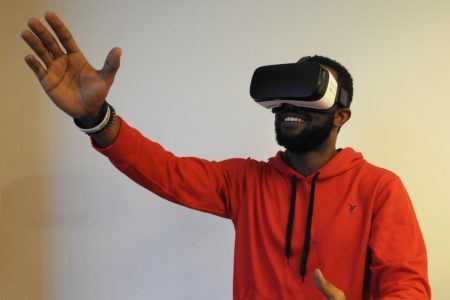April 13, 2020 – In 2010, the retail availability of the Oculus Rift changed the world of entertainment. A product of Oculus VR headed up by entrepreneur Palmer Luckey, Oculus Rift owes its origins to earlier iterations of virtual reality (VR) that first emerged in the mid-20th century. Early developers included the U.S. Airforce and others that built technologies unlike the VR headsets we use today.
For examples, there was CAVE (Cave Automatic Virtual Environment) developed by Electronic Visualization Laboratory, and Armstrong Labs, which experimented with a VR that resembled an exoskeleton worn on the body. Neither achieved commercial success.
Sega, on the other hand, decided to focus its VR on the entertainment and video game sector. It was this industry segment that laid the foundation for the VR revolution. By the mid-1990s, Nintendo and Sega were in a race to perfect game consoles incorporating VR. But it wasn’t until 2010 that a take-home version of VR emerged. The price tag for a VR headset was steep. For example, Oculus Rift headsets cost more than a thousand dollars at the time. And even today consumers can pay $599 for an Oculus headset, and upwards of $700 for competitor headsets like HTC Vive.
But the price tag hasn’t stopped a growing interest in the technology. In March 2019, Sony announced that they had sold 4.2 million PlayStation VR headsets. And in May 2019, the number of VR headset users connecting to Steam, a video game developed specifically for them, surpassed one million.
VR Graduates from Video Game Consoles
VR headsets today are no longer tied to game consoles. They are standalone seemingly giving them endless possible uses in terms of development (though there’s still that price tag). VR’s 3D visualization is now being used in medicine, helping doctors to visualize and understand internal injuries and plan operations. VR is even helping to diagnose patients in remote locations where a physical visit isn’t possible.
In agriculture, VR companies such as M3 Aerial Productions are offering farmers virtual tours of their farms from above in order to better optimize land use. The same can be said for environmental watchdog groups that are using VR for large-scale land surveys. New VR capability may soon allow both farmers and conservationists to examine soil samples at a distance.
NASA is using PointCloudsVR to simulate walking on Mars and the Moon, while similar programs are being adapted for classroom and online education.
Virboo is being used to visualize financial data to optimize investments and savings.
The Emergence of VR for Athletes
Among the newest areas where VR is establishing itself is in athletics. Leagues such as the NFL are turning to the technology to help with player development. Programs once designed to train pilots to fly using simulators are being adapted to suit high-performance athletes’ needs. The idea is to create an environment for athletes to test and hone their skills off the field.
Former Stanford University kicker, Derek Belch, began developing STRIVR in 2016 to cater to football players. An immersive simulation, it uses a VR headset to simulate situations encountered in game conditions.
STRIVR can help a player like the quarterback to perfect skills. The price tag for this VR immersive simulation technology is trivial compared to the $550 million the league spends on its quarterbacks annually. STRIVR’s aim is to turn almost any quarterback into the next Tom Brady, giving them a better chance of reaching the Super Bowl in 2021. That makes an investment in it worthwhile, and so far, it is being used by the Dallas Cowboys and the San Francisco 49ers in the NFL, and the Clemson Tigers in the NCAA.
STRIVR isn’t alone in developing virtual simulations for sports. VTS Sports, founded by another former football player, Ted Sundquist, who played 16 years with the Denver Broncos, has developed QBSIM, a quarterback simulation program designed specifically for that purpose. Unlike STRIVR, VTS Sports is integrating real-life data into its simulation allowing players to not only move around and physically simulate plays, but pitting them against simulated opponents. With VTS, players have to sidestep rushes and read defenses. They can repeat plays without worrying about tiring out a simulated opponent.
Not to be outdone, STRIVR is branching out with a goalie program for the NHL and is even venturing into the fields of entertainment, workplace safety, and immersive learning in retail environments.










